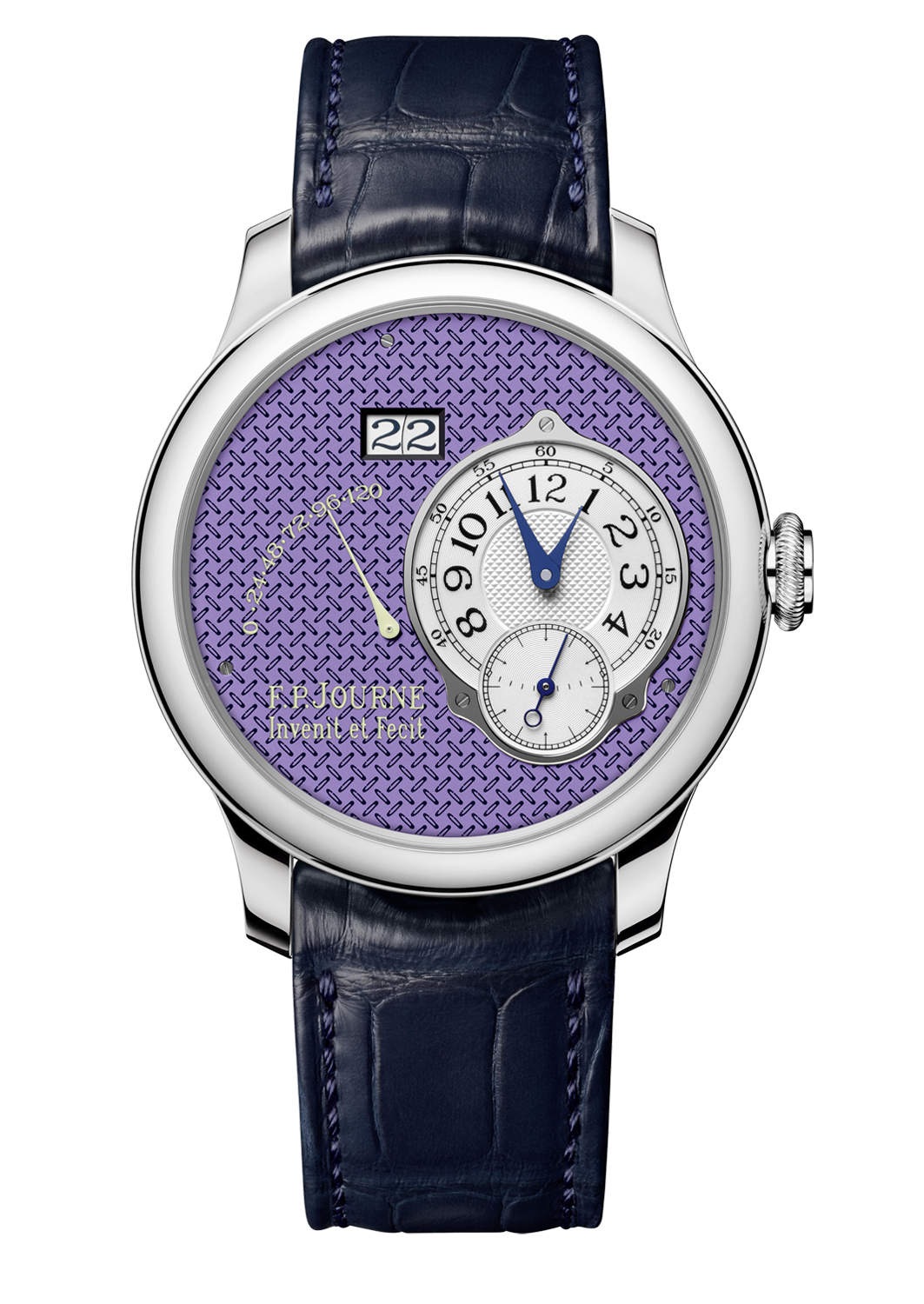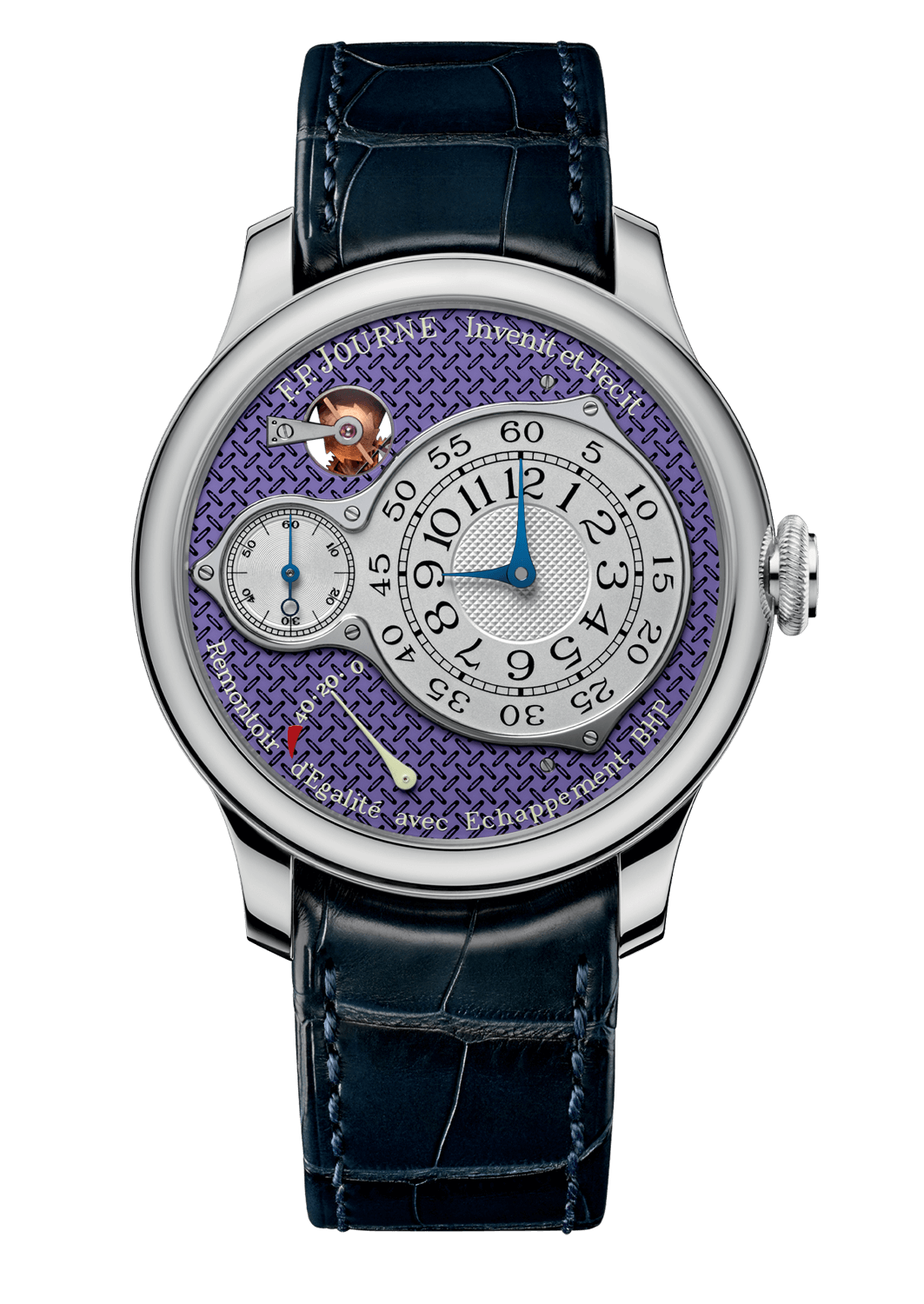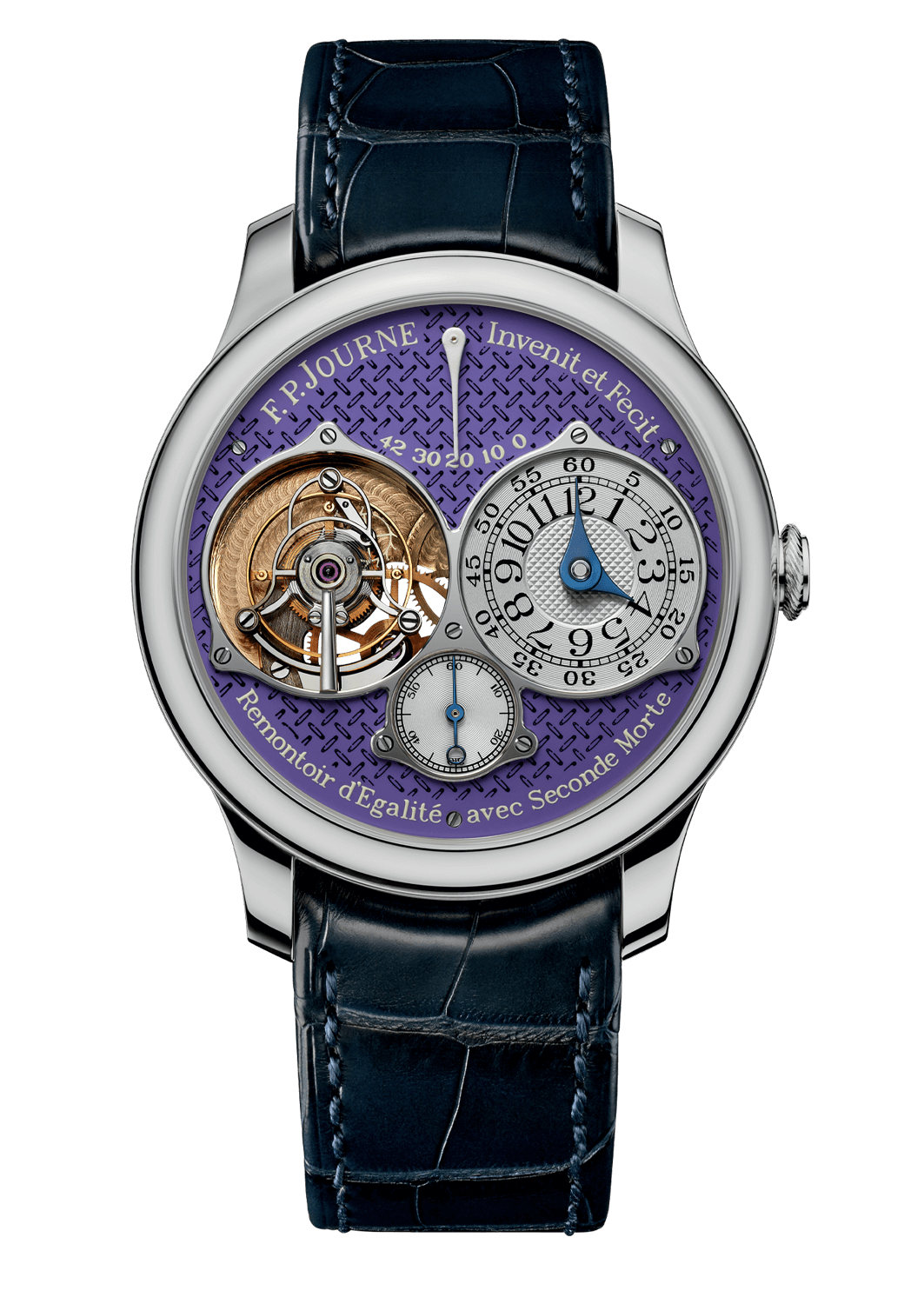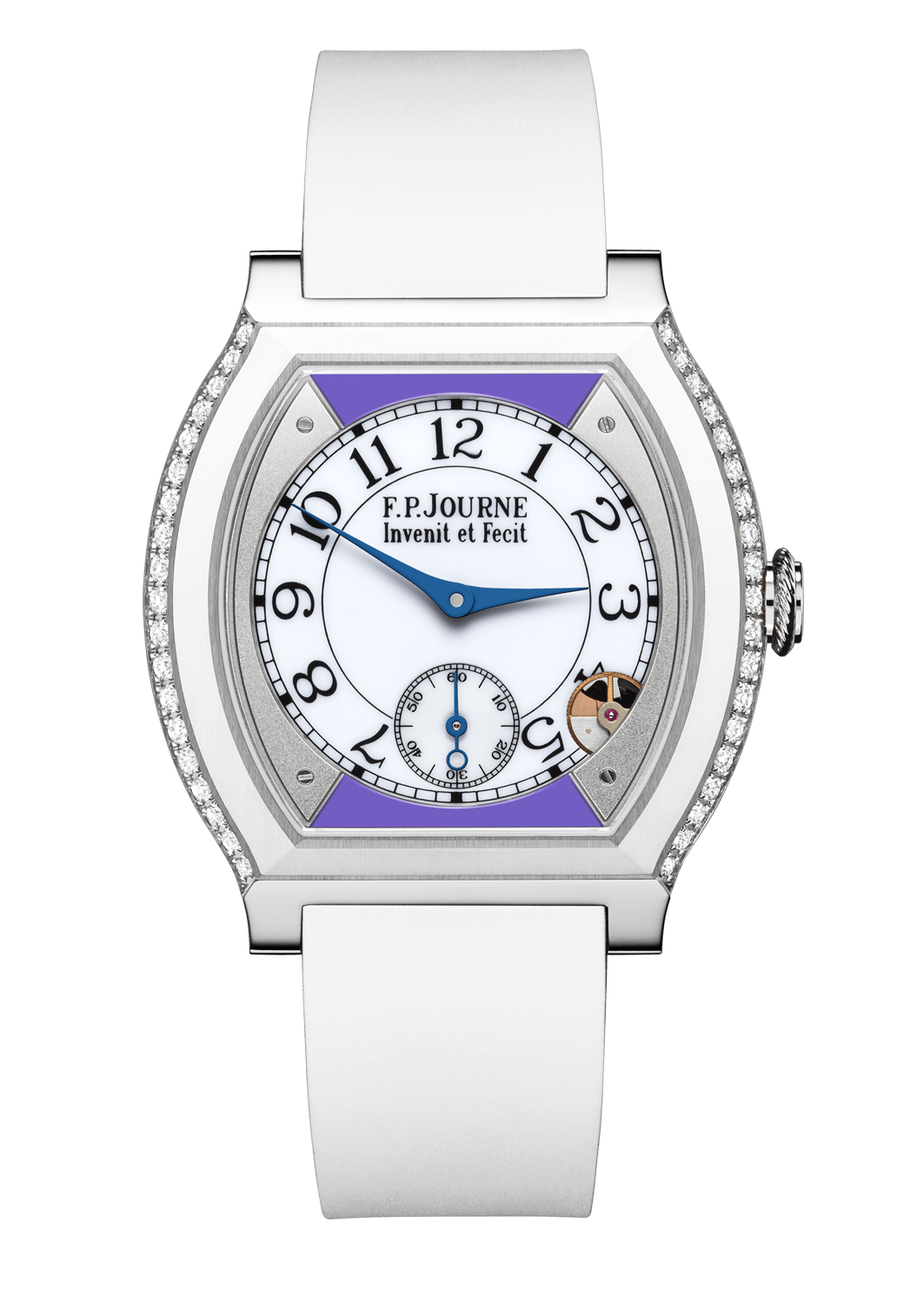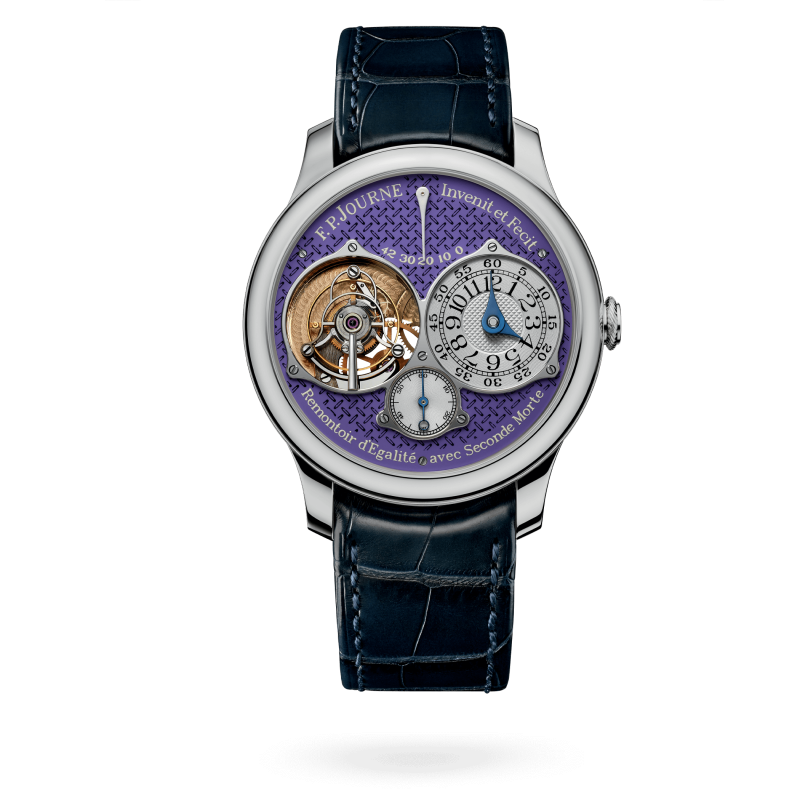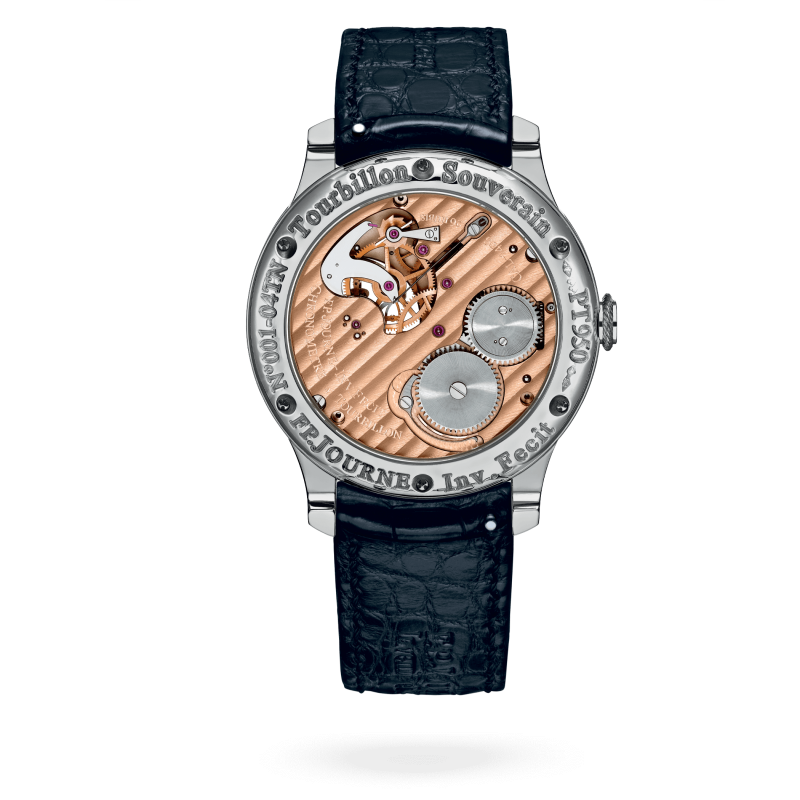Calibre 1403 https://www.fpjourne.com/en/collection/action-innocence-timepieces/tourbillon-souverain-action-innocence-2015 FP Journe https://www.fpjourne.com/en FP Journe

Diameter: 40 mm
Overall height: 9.9 mm
Dial: in the colours of Action Innocence and whitened guilloché Silver
Hands: blued Steel and ivory coloured Steel
Action Innocence is a foundation created in 1999 to preserve the dignity and integrity of children and teenagers in their use of screens and technologies.
Technical Specifications
- Manually winding : 20 turns of the crown
- Movement in 18K rose gold : 26 jewels
Hours and minutes à 3h00
Sub-seconds at 6h00
Power reserve at 12h00
- Overall dimensions : 32.40 mm
- Casing-up diameter : 32.00 mm
- Overall Height : 7.20 mm
- Height of winding stem : 2.53 mm
- Diameter of stem thread : S1.20 mm
- Case diameter : 38 mm / 40.00 mm
- Overall case thickness : 9.9 mm
15 tooth escape wheel
90° Anchor fork
Balance with 4 inertia weights
Flat Anachron balance spring with Breguet overcoil
Pinned stud
Free-sprung
Spring pinned to collet
2 position winding crown
Tourbillon with constant force and dead seconds
Manual winding
Time adjustment by crown in position 2
21'600 VPH, 3 Hz
- Inertia : 11.00 mgcm2
- Angle of lift : 52°
0 h dial up: 280°
24 h dial up: 280°
42 ± 2 hours
26
High quality
Circular stripes on the bridges
Geneva waves on baseplate
Screw heads polished and bevelled
Pegs with polished rounded ends
Movement: 193
Cased on leather strap: 218
- Manually winding : 20 turns of the crown
- Movement in 18K rose gold : 26 jewels
Hours and minutes à 3h00
Sub-seconds at 6h00
Power reserve at 12h00
- Overall dimensions : 32.40 mm
- Casing-up diameter : 32.00 mm
- Overall Height : 7.20 mm
- Height of winding stem : 2.53 mm
- Diameter of stem thread : S1.20 mm
- Case diameter : 38 mm / 40.00 mm
- Overall case thickness : 9.9 mm
15 tooth escape wheel
90° Anchor fork
Balance with 4 inertia weights
Flat Anachron balance spring with Breguet overcoil
Pinned stud
Free-sprung
Spring pinned to collet
2 position winding crown
Tourbillon with constant force and dead seconds
Manual winding
Time adjustment by crown in position 2
21'600 VPH, 3 Hz
- Inertia : 11.00 mgcm2
- Angle of lift : 52°
0 h dial up: 280°
24 h dial up: 280°
42 ± 2 hours
26
High quality
Circular stripes on the bridges
Geneva waves on baseplate
Screw heads polished and bevelled
Pegs with polished rounded ends
Movement: 193
Cased on leather strap: 218
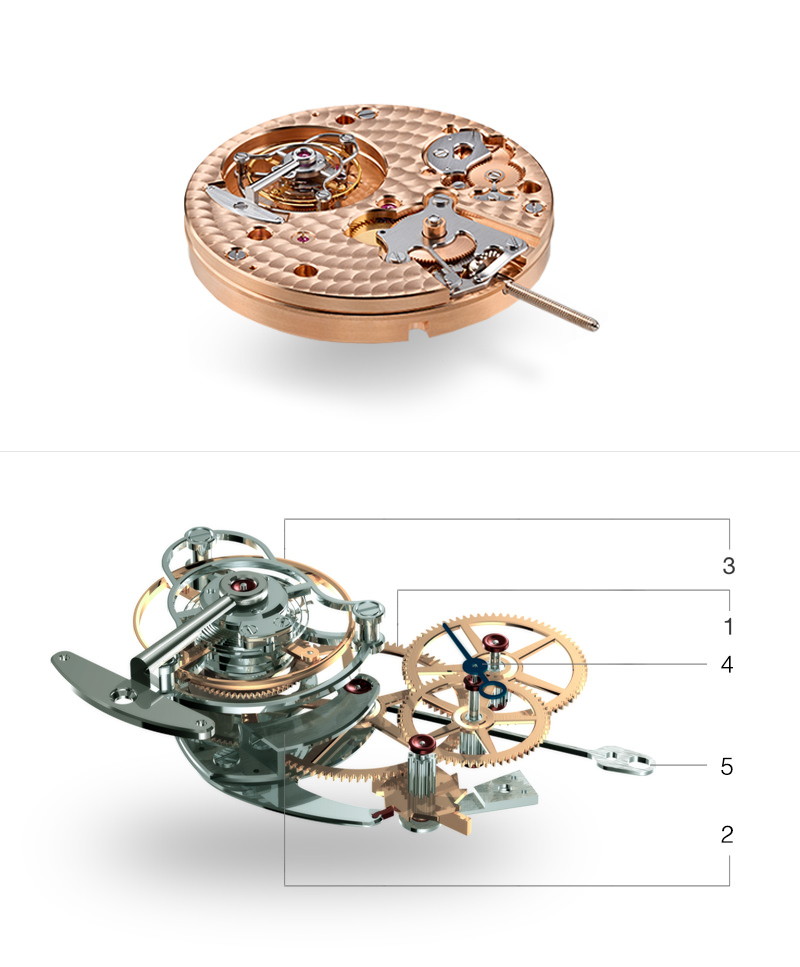
Technical description
The remontoire (constant force device) comprises a secondary wheel (1) assembled on a lever (2), which swivels concentrically to the cage (3) of the tourbillon. This lever stops the principal wheel which carries the second hand (4) and transmits the energy of the barrel, whereas the auxiliary spring (5) (or equalizing spring) gives its energy to the escapement. (6) This then allows the secondary wheel to release once per second, and with repetition, the auxiliary spring is re-fuelled by the principal wheel.
What is a remontoire ?
In the Toubillon Souverain, the remontoire - a constant force device - can be compared to a dam that controls the flow of water and provides constant energy to the blades of a turbine. In effect, the remontoire regulates the power to the escapement to attain greater stability in rate. The adjustable inertia weights make it possible to optimize the amplitude of oscillation; the four-armed balance beats at a frequency of 21'600 v/h.

Technical description
The remontoire (constant force device) comprises a secondary wheel (1) assembled on a lever (2), which swivels concentrically to the cage (3) of the tourbillon. This lever stops the principal wheel which carries the second hand (4) and transmits the energy of the barrel, whereas the auxiliary spring (5) (or equalizing spring) gives its energy to the escapement. (6) This then allows the secondary wheel to release once per second, and with repetition, the auxiliary spring is re-fuelled by the principal wheel.
What is a remontoire ?
In the Toubillon Souverain, the remontoire - a constant force device - can be compared to a dam that controls the flow of water and provides constant energy to the blades of a turbine. In effect, the remontoire regulates the power to the escapement to attain greater stability in rate. The adjustable inertia weights make it possible to optimize the amplitude of oscillation; the four-armed balance beats at a frequency of 21'600 v/h.
Diameter: 40 mm
Overall height: 9.9 mm
Dial: in the colours of Action Innocence and whitened guilloché Silver
Hands: blued Steel and ivory coloured Steel
Action Innocence is a foundation created in 1999 to preserve the dignity and integrity of children and teenagers in their use of screens and technologies.

Diameter: 40 mm
Overall height: 9.9 mm
Dial: in the colours of Action Innocence and whitened guilloché Silver
Hands: blued Steel and ivory coloured Steel
Action Innocence is a foundation created in 1999 to preserve the dignity and integrity of children and teenagers in their use of screens and technologies.
Technical Specifications
- Manually winding : 20 turns of the crown
- Movement in 18K rose gold : 26 jewels
Hours and minutes à 3h00
Sub-seconds at 6h00
Power reserve at 12h00
- Overall dimensions : 32.40 mm
- Casing-up diameter : 32.00 mm
- Overall Height : 7.20 mm
- Height of winding stem : 2.53 mm
- Diameter of stem thread : S1.20 mm
- Case diameter : 38 mm / 40.00 mm
- Overall case thickness : 9.9 mm
15 tooth escape wheel
90° Anchor fork
Balance with 4 inertia weights
Flat Anachron balance spring with Breguet overcoil
Pinned stud
Free-sprung
Spring pinned to collet
2 position winding crown
Tourbillon with constant force and dead seconds
Manual winding
Time adjustment by crown in position 2
21'600 VPH, 3 Hz
- Inertia : 11.00 mgcm2
- Angle of lift : 52°
0 h dial up: 280°
24 h dial up: 280°
42 ± 2 hours
26
High quality
Circular stripes on the bridges
Geneva waves on baseplate
Screw heads polished and bevelled
Pegs with polished rounded ends
Movement: 193
Cased on leather strap: 218
- Manually winding : 20 turns of the crown
- Movement in 18K rose gold : 26 jewels
Hours and minutes à 3h00
Sub-seconds at 6h00
Power reserve at 12h00
- Overall dimensions : 32.40 mm
- Casing-up diameter : 32.00 mm
- Overall Height : 7.20 mm
- Height of winding stem : 2.53 mm
- Diameter of stem thread : S1.20 mm
- Case diameter : 38 mm / 40.00 mm
- Overall case thickness : 9.9 mm
15 tooth escape wheel
90° Anchor fork
Balance with 4 inertia weights
Flat Anachron balance spring with Breguet overcoil
Pinned stud
Free-sprung
Spring pinned to collet
2 position winding crown
Tourbillon with constant force and dead seconds
Manual winding
Time adjustment by crown in position 2
21'600 VPH, 3 Hz
- Inertia : 11.00 mgcm2
- Angle of lift : 52°
0 h dial up: 280°
24 h dial up: 280°
42 ± 2 hours
26
High quality
Circular stripes on the bridges
Geneva waves on baseplate
Screw heads polished and bevelled
Pegs with polished rounded ends
Movement: 193
Cased on leather strap: 218

Technical description
The remontoire (constant force device) comprises a secondary wheel (1) assembled on a lever (2), which swivels concentrically to the cage (3) of the tourbillon. This lever stops the principal wheel which carries the second hand (4) and transmits the energy of the barrel, whereas the auxiliary spring (5) (or equalizing spring) gives its energy to the escapement. (6) This then allows the secondary wheel to release once per second, and with repetition, the auxiliary spring is re-fuelled by the principal wheel.
What is a remontoire ?
In the Toubillon Souverain, the remontoire - a constant force device - can be compared to a dam that controls the flow of water and provides constant energy to the blades of a turbine. In effect, the remontoire regulates the power to the escapement to attain greater stability in rate. The adjustable inertia weights make it possible to optimize the amplitude of oscillation; the four-armed balance beats at a frequency of 21'600 v/h.

Technical description
The remontoire (constant force device) comprises a secondary wheel (1) assembled on a lever (2), which swivels concentrically to the cage (3) of the tourbillon. This lever stops the principal wheel which carries the second hand (4) and transmits the energy of the barrel, whereas the auxiliary spring (5) (or equalizing spring) gives its energy to the escapement. (6) This then allows the secondary wheel to release once per second, and with repetition, the auxiliary spring is re-fuelled by the principal wheel.
What is a remontoire ?
In the Toubillon Souverain, the remontoire - a constant force device - can be compared to a dam that controls the flow of water and provides constant energy to the blades of a turbine. In effect, the remontoire regulates the power to the escapement to attain greater stability in rate. The adjustable inertia weights make it possible to optimize the amplitude of oscillation; the four-armed balance beats at a frequency of 21'600 v/h.
About
THE AUCTION WAS VERY LIVELY: UNDER THE GAVEL OF AUREL BACS, ROBERT MANOUKIAN AND CLAUDE SFEIR WERE BIDDING AGAINST EACH OTHER UP TO CHF 350’000, I.E. 2.35 TIMES ITS PRICE. CLAUDE SFEIR WON THE BATTLE, AND IN A BURST OF GENEROSITY, ROBERT MANOUKIAN ADDED ANOTHER CHF 300’000 TO THE ADJUDICATED PRICE AT THE PROFIT OF THE FOUNDATION. https://www.actioninnocence.org/anglais/.
IN 1999, FRANÇOIS-PAUL JOURNE LAUNCHED HIS F.P.JOURNE -INVENIT ET FECIT- BRAND WITH THE TOURBILLON SOUVERAIN, THE FIRST MODEL IN THE SOUVERAINE COLLECTION AND THE ONLY TOURBILLON WRISTWATCH WITH REMONTOIRE (CONSTANT FORCE DEVICE).
THIS INVENIT ET FECIT- MECHANISM, INVENTED AND MADE BY FRANÇOIS-PAUL JOURNE, PROVIDES UNIQUE TIMEKEEPING PERFORMANCE IN A TOURBILLON WHICH IS STILL THE MOST ACCURATE ON THE MARKET.
in 2004, dRIVEN BY HIS THIRST FOR TIMEKEEPING RESEARCH AND HIS CREATIVE NEEDS, FRANÇOIS-PAUL JOURNE PRESENTed THE NEW GENERATION OF TOURBILLON SOUVERAIN, WITH REMONTOIRE AND DEAD BEAT SECONDS. THIS MODEL REPLACEd THE EXISTING TOURBILLON SOUVERAIN WITH REMONTOIRE that became a COLLECTOR'S timepiece. as only aBOUT A HUNDRED were produced give this watch an even more SOUGHT-AFTER STATUS.
THE TOURBILLON SOUVERAIN WITH REMONTOIRE AND DEAD BEAT SECONDS IS ENDOWED WITH THE CHARACTERISTICS AND TECHNICAL DEMANDS INHERENT TO CREATIONS BY F.P. JOURNE - INVENIT ET FECIT -. ITS MECHANISM USES THE REMONTOIRE OR CONSTANT FORCE DEVICE, WHICH THE BRAND VALUES FOR ITS TIMEKEEPING PERFORMANCES, AND HAS NOW BEEN ENRICHED WITH AN INDEPENDENT 'DEAD BEAT SECONDS' SYSTEM. THIS COMPLICATION, REPRESENTING A UNIQUE FEATURE ON A CONTEMPORARY WRISTWATCH, PROVIDES FOR A MORE ACCURATE READ OF PRECISE TIME. THE FRENCH TERM FOR "INDEPENDENT SECONDS", CALLED "SECONDE MORTE" OR "DEAD BEAT SECONDS", STEMS FROM THE FACT THAT THE HAND REMAINS MOTIONLESS ("DEAD") FOR AS LONG AS THE SECOND HAS NOT ACTUALLY ELAPSED. THE HAND THUS INDICATES THE SECOND ONLY AFTER IT HAS ACTUALLY PAST.
THIS EXCEPTIONAL MECHANISM IS HOUSED IN AN EQUALLY NOBLE 40 MM CASE IN PLATINUM. THE BEAUTY AND SOPHISTICATION OF THIS TECHNICAL AND AESTHETIC FEAT ARE REVEALED THROUGH THE TRANSPARENT SAPPHIRE CRYSTAL CASE-BACK.
THE DIAL FEATURES THE DISTINCTIVE IDENTITY OF THE F.P.JOURNE CHRONOMETERS WITH STEEL CIRCLES SCREWED ON THE FACE (A PATENTED FEATURE). HOURS, MINUTES AND SECONDS’ DIALS ARE MADE IN SILVER "GUILLOCHÉ". THE 42-HOUR POWER RESERVE INDICATION AT 12 O'CLOCK PERFECTLY COUNTER-BALANCES THE INDEPENDENT SECONDS DISPLAY AT 6 O'CLOCK.
“From ancient times, humankind has constantly attempted to measure time by dividing it into equal fractions and inventing the notion of isochronism! Only with the arrival of the first mechanical clocks did specialists begin to seek a means of equalising the force reaching the escapement. The balance-spring did not yet exist and the so-called “foliot” balance had an irregular beat due to the arrival of a force varying because of the imperfections of the gearing. At the time, clocks were equipped with just one hand which completed a revolution once every 12 hours, since their degree of imprecision did not permit the measurement of minutes. After the invention of the mainspring, which would enable the construction of table-clocks, 15th century watchmaker Jobst Bürgi had the idea of adding an extra gear representing an independent system wound in short spurts by the mainspring.
The escapement thus ensured a more constant flow and enabled an autonomy of several months: this was the first remontoire or constant-force device!
Later, 17th century Dutch watchmaker Christiaan Huygens invented the balance-spring and the pendulum. These innovations would give both clocks and watches an unprecedented degree of precision timekeeping: the minute hand became widespread and the constant-force device fell into oblivion for around a century. With the arrival of the 18th century, known as the Age of Enlightenment, the high requirements relating to astronomical observations and calculations of longitude for maritime navigation called for ever higher levels of precision. As new technical solutions were found, the seconds hand became a common feature on watches of the period. In England, Thomas Mudge invented a constant-force device for the H.3 marine chronometer, while famous French watchmaker Robert Robin – Watchmaker to the King – also invented one for his precision regulators. Paradoxically, it was in the 19th century that the constant-force device became widely used in the construction of clocks intended for buildings – not to remedy any flaws in the springs (since all these clocks ran by driving-weights), but to isolate the time mechanism from the outside hands. This was because the latter were exposed to strong winds and might disturb the mechanism.
Nonetheless, making a constant-force device was a complex and tedious task, causing it to be almost entirely abandoned in the 20th century, apart from a few rare exceptions: English watchmaker Georges Daniels used it in a tourbillon pocket-watch; his contemporary Anthony Randall built it into a table-clock based on the principle of John Harrison’s H.4; and I myself have incorporated it into three tourbillon pocket-watches, a so-called “sympathique” clock and more recently for the very first time in wristwatch form with the first model in the F.P.Journe – Invenit et Fecit – collection, the Tourbillon Souverain.
What is fascinating in the principle of the constant-force device is that each watchmaker who has set out to build one has his own personal interpretation: only the basic idea remains the same.”
François-Paul Journe
Technical Specifications
- Manually winding : 20 turns of the crown
- Movement in 18K rose gold : 26 jewels
Hours and minutes à 3h00
Sub-seconds at 6h00
Power reserve at 12h00
- Overall dimensions : 32.40 mm
- Casing-up diameter : 32.00 mm
- Overall Height : 7.20 mm
- Height of winding stem : 2.53 mm
- Diameter of stem thread : S1.20 mm
- Case diameter : 38 mm / 40.00 mm
- Overall case thickness : 9.9 mm
15 tooth escape wheel
90° Anchor fork
Balance with 4 inertia weights
Flat Anachron balance spring with Breguet overcoil
Pinned stud
Free-sprung
Spring pinned to collet
2 position winding crown
Tourbillon with constant force and dead seconds
Manual winding
Time adjustment by crown in position 2
21'600 VPH, 3 Hz
- Inertia : 11.00 mgcm2
- Angle of lift : 52°
0 h dial up: 280°
24 h dial up: 280°
42 ± 2 hours
26
High quality
Circular stripes on the bridges
Geneva waves on baseplate
Screw heads polished and bevelled
Pegs with polished rounded ends
Movement: 193
Cased on leather strap: 218
- Manually winding : 20 turns of the crown
- Movement in 18K rose gold : 26 jewels
Hours and minutes à 3h00
Sub-seconds at 6h00
Power reserve at 12h00
- Overall dimensions : 32.40 mm
- Casing-up diameter : 32.00 mm
- Overall Height : 7.20 mm
- Height of winding stem : 2.53 mm
- Diameter of stem thread : S1.20 mm
- Case diameter : 38 mm / 40.00 mm
- Overall case thickness : 9.9 mm
15 tooth escape wheel
90° Anchor fork
Balance with 4 inertia weights
Flat Anachron balance spring with Breguet overcoil
Pinned stud
Free-sprung
Spring pinned to collet
2 position winding crown
Tourbillon with constant force and dead seconds
Manual winding
Time adjustment by crown in position 2
21'600 VPH, 3 Hz
- Inertia : 11.00 mgcm2
- Angle of lift : 52°
0 h dial up: 280°
24 h dial up: 280°
42 ± 2 hours
26
High quality
Circular stripes on the bridges
Geneva waves on baseplate
Screw heads polished and bevelled
Pegs with polished rounded ends
Movement: 193
Cased on leather strap: 218

Technical description
The remontoire (constant force device) comprises a secondary wheel (1) assembled on a lever (2), which swivels concentrically to the cage (3) of the tourbillon. This lever stops the principal wheel which carries the second hand (4) and transmits the energy of the barrel, whereas the auxiliary spring (5) (or equalizing spring) gives its energy to the escapement. (6) This then allows the secondary wheel to release once per second, and with repetition, the auxiliary spring is re-fuelled by the principal wheel.
What is a remontoire ?
In the Toubillon Souverain, the remontoire - a constant force device - can be compared to a dam that controls the flow of water and provides constant energy to the blades of a turbine. In effect, the remontoire regulates the power to the escapement to attain greater stability in rate. The adjustable inertia weights make it possible to optimize the amplitude of oscillation; the four-armed balance beats at a frequency of 21'600 v/h.

Technical description
The remontoire (constant force device) comprises a secondary wheel (1) assembled on a lever (2), which swivels concentrically to the cage (3) of the tourbillon. This lever stops the principal wheel which carries the second hand (4) and transmits the energy of the barrel, whereas the auxiliary spring (5) (or equalizing spring) gives its energy to the escapement. (6) This then allows the secondary wheel to release once per second, and with repetition, the auxiliary spring is re-fuelled by the principal wheel.
What is a remontoire ?
In the Toubillon Souverain, the remontoire - a constant force device - can be compared to a dam that controls the flow of water and provides constant energy to the blades of a turbine. In effect, the remontoire regulates the power to the escapement to attain greater stability in rate. The adjustable inertia weights make it possible to optimize the amplitude of oscillation; the four-armed balance beats at a frequency of 21'600 v/h.
-
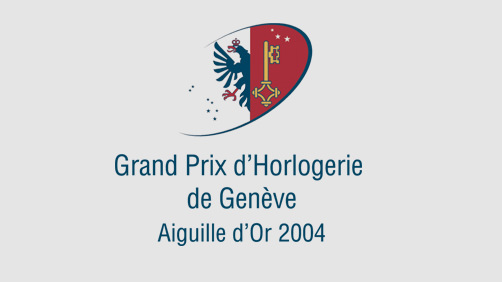
Aiguille d'Or 2004
-
About
ON MAY 12, 2015 - CHF 650'000 FOR THIS UNIQUE TOURBILLON SOUVERAIN AT THE CHARITY GALA ORGANIZED FOR THE 15TH ANNIVERSARY OF ACTION INNOCENCE.
THE AUCTION WAS VERY LIVELY: UNDER THE GAVEL OF AUREL BACS, ROBERT MANOUKIAN AND CLAUDE SFEIR WERE BIDDING AGAINST EACH OTHER UP TO CHF 350’000, I.E. 2.35 TIMES ITS PRICE. CLAUDE SFEIR WON THE BATTLE, AND IN A BURST OF GENEROSITY, ROBERT MANOUKIAN ADDED ANOTHER CHF 300’000 TO THE ADJUDICATED PRICE AT THE PROFIT OF THE FOUNDATION. https://www.actioninnocence.org/anglais/.
IN 1999, FRANÇOIS-PAUL JOURNE LAUNCHED HIS F.P.JOURNE -INVENIT ET FECIT- BRAND WITH THE TOURBILLON SOUVERAIN, THE FIRST MODEL IN THE SOUVERAINE COLLECTION AND THE ONLY TOURBILLON WRISTWATCH WITH REMONTOIRE (CONSTANT FORCE DEVICE).
THIS INVENIT ET FECIT- MECHANISM, INVENTED AND MADE BY FRANÇOIS-PAUL JOURNE, PROVIDES UNIQUE TIMEKEEPING PERFORMANCE IN A TOURBILLON WHICH IS STILL THE MOST ACCURATE ON THE MARKET.
in 2004, dRIVEN BY HIS THIRST FOR TIMEKEEPING RESEARCH AND HIS CREATIVE NEEDS, FRANÇOIS-PAUL JOURNE PRESENTed THE NEW GENERATION OF TOURBILLON SOUVERAIN, WITH REMONTOIRE AND DEAD BEAT SECONDS. THIS MODEL REPLACEd THE EXISTING TOURBILLON SOUVERAIN WITH REMONTOIRE that became a COLLECTOR'S timepiece. as only aBOUT A HUNDRED were produced give this watch an even more SOUGHT-AFTER STATUS.
THE TOURBILLON SOUVERAIN WITH REMONTOIRE AND DEAD BEAT SECONDS IS ENDOWED WITH THE CHARACTERISTICS AND TECHNICAL DEMANDS INHERENT TO CREATIONS BY F.P. JOURNE - INVENIT ET FECIT -. ITS MECHANISM USES THE REMONTOIRE OR CONSTANT FORCE DEVICE, WHICH THE BRAND VALUES FOR ITS TIMEKEEPING PERFORMANCES, AND HAS NOW BEEN ENRICHED WITH AN INDEPENDENT 'DEAD BEAT SECONDS' SYSTEM. THIS COMPLICATION, REPRESENTING A UNIQUE FEATURE ON A CONTEMPORARY WRISTWATCH, PROVIDES FOR A MORE ACCURATE READ OF PRECISE TIME. THE FRENCH TERM FOR "INDEPENDENT SECONDS", CALLED "SECONDE MORTE" OR "DEAD BEAT SECONDS", STEMS FROM THE FACT THAT THE HAND REMAINS MOTIONLESS ("DEAD") FOR AS LONG AS THE SECOND HAS NOT ACTUALLY ELAPSED. THE HAND THUS INDICATES THE SECOND ONLY AFTER IT HAS ACTUALLY PAST.
THIS EXCEPTIONAL MECHANISM IS HOUSED IN AN EQUALLY NOBLE 40 MM CASE IN PLATINUM. THE BEAUTY AND SOPHISTICATION OF THIS TECHNICAL AND AESTHETIC FEAT ARE REVEALED THROUGH THE TRANSPARENT SAPPHIRE CRYSTAL CASE-BACK.
THE DIAL FEATURES THE DISTINCTIVE IDENTITY OF THE F.P.JOURNE CHRONOMETERS WITH STEEL CIRCLES SCREWED ON THE FACE (A PATENTED FEATURE). HOURS, MINUTES AND SECONDS’ DIALS ARE MADE IN SILVER "GUILLOCHÉ". THE 42-HOUR POWER RESERVE INDICATION AT 12 O'CLOCK PERFECTLY COUNTER-BALANCES THE INDEPENDENT SECONDS DISPLAY AT 6 O'CLOCK. -
Testimony
Tourbillon Souverain
“From ancient times, humankind has constantly attempted to measure time by dividing it into equal fractions and inventing the notion of isochronism! Only with the arrival of the first mechanical clocks did specialists begin to seek a means of equalising the force reaching the escapement. The balance-spring did not yet exist and the so-called “foliot” balance had an irregular beat due to the arrival of a force varying because of the imperfections of the gearing. At the time, clocks were equipped with just one hand which completed a revolution once every 12 hours, since their degree of imprecision did not permit the measurement of minutes. After the invention of the mainspring, which would enable the construction of table-clocks, 15th century watchmaker Jobst Bürgi had the idea of adding an extra gear representing an independent system wound in short spurts by the mainspring.
The escapement thus ensured a more constant flow and enabled an autonomy of several months: this was the first remontoire or constant-force device!
Later, 17th century Dutch watchmaker Christiaan Huygens invented the balance-spring and the pendulum. These innovations would give both clocks and watches an unprecedented degree of precision timekeeping: the minute hand became widespread and the constant-force device fell into oblivion for around a century. With the arrival of the 18th century, known as the Age of Enlightenment, the high requirements relating to astronomical observations and calculations of longitude for maritime navigation called for ever higher levels of precision. As new technical solutions were found, the seconds hand became a common feature on watches of the period. In England, Thomas Mudge invented a constant-force device for the H.3 marine chronometer, while famous French watchmaker Robert Robin – Watchmaker to the King – also invented one for his precision regulators. Paradoxically, it was in the 19th century that the constant-force device became widely used in the construction of clocks intended for buildings – not to remedy any flaws in the springs (since all these clocks ran by driving-weights), but to isolate the time mechanism from the outside hands. This was because the latter were exposed to strong winds and might disturb the mechanism.
Nonetheless, making a constant-force device was a complex and tedious task, causing it to be almost entirely abandoned in the 20th century, apart from a few rare exceptions: English watchmaker Georges Daniels used it in a tourbillon pocket-watch; his contemporary Anthony Randall built it into a table-clock based on the principle of John Harrison’s H.4; and I myself have incorporated it into three tourbillon pocket-watches, a so-called “sympathique” clock and more recently for the very first time in wristwatch form with the first model in the F.P.Journe – Invenit et Fecit – collection, the Tourbillon Souverain.
What is fascinating in the principle of the constant-force device is that each watchmaker who has set out to build one has his own personal interpretation: only the basic idea remains the same.”
François-Paul Journe -
Technical description
Technical Specifications
Movement :- Manually winding : 20 turns of the crown
- Movement in 18K rose gold : 26 jewels
Indications :Hours and minutes à 3h00
Sub-seconds at 6h00
Power reserve at 12h00Dimensions :- Overall dimensions : 32.40 mm
- Casing-up diameter : 32.00 mm
- Overall Height : 7.20 mm
- Height of winding stem : 2.53 mm
- Diameter of stem thread : S1.20 mm
- Case diameter : 38 mm / 40.00 mm
- Overall case thickness : 9.9 mm
Particularities :15 tooth escape wheel
90° Anchor fork
Balance with 4 inertia weights
Flat Anachron balance spring with Breguet overcoil
Pinned stud
Free-sprung
Spring pinned to collet
2 position winding crownCharacteristics :Tourbillon with constant force and dead seconds
Manual winding
Time adjustment by crown in position 2FREQUENCY :21'600 VPH, 3 Hz
Balance :- Inertia : 11.00 mgcm2
- Angle of lift : 52°
Amplitude :0 h dial up: 280°
24 h dial up: 280°Autonomy :42 ± 2 hours
Number of jewels :26
Finishes :High quality
Circular stripes on the bridges
Geneva waves on baseplate
Screw heads polished and bevelled
Pegs with polished rounded endsNumber of components :Movement: 193
Cased on leather strap: 218Movement :- Manually winding : 20 turns of the crown
- Movement in 18K rose gold : 26 jewels
Indications :Hours and minutes à 3h00
Sub-seconds at 6h00
Power reserve at 12h00Dimensions :- Overall dimensions : 32.40 mm
- Casing-up diameter : 32.00 mm
- Overall Height : 7.20 mm
- Height of winding stem : 2.53 mm
- Diameter of stem thread : S1.20 mm
- Case diameter : 38 mm / 40.00 mm
- Overall case thickness : 9.9 mm
Particularities :15 tooth escape wheel
90° Anchor fork
Balance with 4 inertia weights
Flat Anachron balance spring with Breguet overcoil
Pinned stud
Free-sprung
Spring pinned to collet
2 position winding crownCharacteristics :Tourbillon with constant force and dead seconds
Manual winding
Time adjustment by crown in position 2FREQUENCY :21'600 VPH, 3 Hz
Balance :- Inertia : 11.00 mgcm2
- Angle of lift : 52°
Amplitude :0 h dial up: 280°
24 h dial up: 280°Autonomy :42 ± 2 hours
Number of jewels :26
Finishes :High quality
Circular stripes on the bridges
Geneva waves on baseplate
Screw heads polished and bevelled
Pegs with polished rounded endsNumber of components :Movement: 193
Cased on leather strap: 218
At the heart of the movementAt the heart of the movementBrevet - EP 1 760 544 A1 | EP 03405772.9Technical description
The remontoire (constant force device) comprises a secondary wheel (1) assembled on a lever (2), which swivels concentrically to the cage (3) of the tourbillon. This lever stops the principal wheel which carries the second hand (4) and transmits the energy of the barrel, whereas the auxiliary spring (5) (or equalizing spring) gives its energy to the escapement. (6) This then allows the secondary wheel to release once per second, and with repetition, the auxiliary spring is re-fuelled by the principal wheel.
What is a remontoire ?
In the Toubillon Souverain, the remontoire - a constant force device - can be compared to a dam that controls the flow of water and provides constant energy to the blades of a turbine. In effect, the remontoire regulates the power to the escapement to attain greater stability in rate. The adjustable inertia weights make it possible to optimize the amplitude of oscillation; the four-armed balance beats at a frequency of 21'600 v/h.Brevet - EP 1 760 544 A1 | EP 03405772.9
Technical description
The remontoire (constant force device) comprises a secondary wheel (1) assembled on a lever (2), which swivels concentrically to the cage (3) of the tourbillon. This lever stops the principal wheel which carries the second hand (4) and transmits the energy of the barrel, whereas the auxiliary spring (5) (or equalizing spring) gives its energy to the escapement. (6) This then allows the secondary wheel to release once per second, and with repetition, the auxiliary spring is re-fuelled by the principal wheel.
What is a remontoire ?
In the Toubillon Souverain, the remontoire - a constant force device - can be compared to a dam that controls the flow of water and provides constant energy to the blades of a turbine. In effect, the remontoire regulates the power to the escapement to attain greater stability in rate. The adjustable inertia weights make it possible to optimize the amplitude of oscillation; the four-armed balance beats at a frequency of 21'600 v/h.
Technical Specifications
- Manually winding : 20 turns of the crown
- Movement in 18K rose gold : 26 jewels
Hours and minutes à 3h00
Sub-seconds at 6h00
Power reserve at 12h00
- Overall dimensions : 32.40 mm
- Casing-up diameter : 32.00 mm
- Overall Height : 7.20 mm
- Height of winding stem : 2.53 mm
- Diameter of stem thread : S1.20 mm
- Case diameter : 38 mm / 40.00 mm
- Overall case thickness : 9.9 mm
15 tooth escape wheel
90° Anchor fork
Balance with 4 inertia weights
Flat Anachron balance spring with Breguet overcoil
Pinned stud
Free-sprung
Spring pinned to collet
2 position winding crown
Tourbillon with constant force and dead seconds
Manual winding
Time adjustment by crown in position 2
21'600 VPH, 3 Hz
- Inertia : 11.00 mgcm2
- Angle of lift : 52°
0 h dial up: 280°
24 h dial up: 280°
42 ± 2 hours
26
High quality
Circular stripes on the bridges
Geneva waves on baseplate
Screw heads polished and bevelled
Pegs with polished rounded ends
Movement: 193
Cased on leather strap: 218
- Manually winding : 20 turns of the crown
- Movement in 18K rose gold : 26 jewels
Hours and minutes à 3h00
Sub-seconds at 6h00
Power reserve at 12h00
- Overall dimensions : 32.40 mm
- Casing-up diameter : 32.00 mm
- Overall Height : 7.20 mm
- Height of winding stem : 2.53 mm
- Diameter of stem thread : S1.20 mm
- Case diameter : 38 mm / 40.00 mm
- Overall case thickness : 9.9 mm
15 tooth escape wheel
90° Anchor fork
Balance with 4 inertia weights
Flat Anachron balance spring with Breguet overcoil
Pinned stud
Free-sprung
Spring pinned to collet
2 position winding crown
Tourbillon with constant force and dead seconds
Manual winding
Time adjustment by crown in position 2
21'600 VPH, 3 Hz
- Inertia : 11.00 mgcm2
- Angle of lift : 52°
0 h dial up: 280°
24 h dial up: 280°
42 ± 2 hours
26
High quality
Circular stripes on the bridges
Geneva waves on baseplate
Screw heads polished and bevelled
Pegs with polished rounded ends
Movement: 193
Cased on leather strap: 218

Technical description
The remontoire (constant force device) comprises a secondary wheel (1) assembled on a lever (2), which swivels concentrically to the cage (3) of the tourbillon. This lever stops the principal wheel which carries the second hand (4) and transmits the energy of the barrel, whereas the auxiliary spring (5) (or equalizing spring) gives its energy to the escapement. (6) This then allows the secondary wheel to release once per second, and with repetition, the auxiliary spring is re-fuelled by the principal wheel.
What is a remontoire ?
In the Toubillon Souverain, the remontoire - a constant force device - can be compared to a dam that controls the flow of water and provides constant energy to the blades of a turbine. In effect, the remontoire regulates the power to the escapement to attain greater stability in rate. The adjustable inertia weights make it possible to optimize the amplitude of oscillation; the four-armed balance beats at a frequency of 21'600 v/h.

Technical description
The remontoire (constant force device) comprises a secondary wheel (1) assembled on a lever (2), which swivels concentrically to the cage (3) of the tourbillon. This lever stops the principal wheel which carries the second hand (4) and transmits the energy of the barrel, whereas the auxiliary spring (5) (or equalizing spring) gives its energy to the escapement. (6) This then allows the secondary wheel to release once per second, and with repetition, the auxiliary spring is re-fuelled by the principal wheel.
What is a remontoire ?
In the Toubillon Souverain, the remontoire - a constant force device - can be compared to a dam that controls the flow of water and provides constant energy to the blades of a turbine. In effect, the remontoire regulates the power to the escapement to attain greater stability in rate. The adjustable inertia weights make it possible to optimize the amplitude of oscillation; the four-armed balance beats at a frequency of 21'600 v/h.
